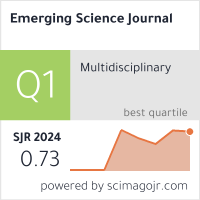Green Human Resources Practices and Person-Organization Fit: The Moderating Role of the Personal Environmental Commitment
Downloads
Doi:10.28991/ESJ-2022-06-05-02
Full Text:PDF
Downloads
World Commission on Environment and Development (WCED). (1987). World commission on environment and development. Our common future, 17(1), 1-91. Available online: https://idl-bnc-idrc.dspacedirect.org/ bitstream/handle/10625/ 152/WCED_v17_doc149.pdf (accessed on February 2022).
Elkington, J. (1998). Partnerships from cannibals with forks: The triple bottom line of 21st-century business. Environmental Quality Management, 8(1), 37–51. doi:10.1002/tqem.3310080106.
Coelho, M. P., Cesário, F., Sabino, A., & Moreira, A. (2022). Pro-Environmental Messages in Job Advertisements and the Intentions to Apply”The Mediating Role of Organizational Attractiveness. Sustainability (Switzerland), 14(5), 3014. doi:10.3390/su14053014.
Paillé, P., Chen, Y., Boiral, O., & Jin, J. (2014). The Impact of Human Resource Management on Environmental Performance: An Employee-Level Study. Journal of Business Ethics, 121(3), 451–466. doi:10.1007/s10551-013-1732-0.
Ahmad, S. (2015). Green Human Resource Management: Policies and practices. Cogent Business and Management, 2(1), 1–13. doi:10.1080/23311975.2015.1030817.
Zubair, D. S. S., & Khan, M. (2019). Sustainable development: The role of green HRM. International Journal of Research in Human Resource Management, 1(2), 1-6.
Ren, S., Tang, G., & E. Jackson, S. (2018). Green human resource management research in emergence: A review and future directions. Asia Pacific Journal of Management, 35(3), 769–803. doi:10.1007/s10490-017-9532-1.
Cesário, F. (2015). Employees perceptions of the importance of human resources management practices. Research Journal of Business Management, 9(3), 470–479. doi:10.3923/rjbm.2015.470.479.
Shen, J., Dumont, J., & Deng, X. (2018). Employees' Perceptions of Green HRM and Non-Green Employee Work Outcomes: The Social Identity and Stakeholder Perspectives. Group and Organization Management, 43(4), 594–622. doi:10.1177/1059601116664610.
Jabbar, M. H., & Abid, M. (2015). A study of green HR practices and its impact on environmental performance: A review. Management Research Report, 3(8), 142-154.
Ansari, N. Y., Farrukh, M., & Raza, A. (2021). Green human resource management and employees pro-environmental behaviours: Examining the underlying mechanism. Corporate Social Responsibility and Environmental Management, 28(1), 229–238. doi:10.1002/csr.2044.
Yusoff, Y. M., Nejati, M., Kee, D. M. H., & Amran, A. (2020). Linking Green Human Resource Management Practices to Environmental Performance in Hotel Industry. Global Business Review, 21(3), 663–680. doi:10.1177/0972150918779294.
Paauwe, J., & Boselie, P. (2005). HRM and performance: What next? Human Resource Management Journal, 15(4), 68–83. doi:10.1111/j.1748-8583.2005.tb00296.x.
Singh, S. K., Giudice, M. D., Chierici, R., & Graziano, D. (2020). Green innovation and environmental performance: The role of green transformational leadership and green human resource management. Technological Forecasting and Social Change, 150, 119762. doi:10.1016/j.techfore.2019.119762.
Hofer, C., Cantor, D. E., & Dai, J. (2012). The competitive determinants of a firm's environmental management activities: Evidence from US manufacturing industries. Journal of Operations Management, 30(1–2), 69–84. doi:10.1016/j.jom.2011.06.002.
Mårtensson, K., & Westerberg, K. (2016). Corporate Environmental Strategies towards Sustainable Development. Business Strategy and the Environment, 25(1), 1–9. doi:10.1002/bse.1852.
Yu, J., Lo, C. W. H., & Li, P. H. Y. (2017). Organizational Visibility, Stakeholder Environmental Pressure and Corporate Environmental Responsiveness in China. Business Strategy and the Environment, 26(3), 371–384. doi:10.1002/bse.1923.
Wang, S., Li, J., & Zhao, D. (2018). Institutional Pressures and Environmental Management Practices: The Moderating Effects of Environmental Commitment and Resource Availability. Business Strategy and the Environment, 27(1), 52–69. doi:10.1002/bse.1983.
Montabon, F., Sroufe, R., & Narasimhan, R. (2007). An examination of corporate reporting, environmental management practices and firm performance. Journal of Operations Management, 25(5), 998–1014. doi:10.1016/j.jom.2006.10.003.
Bowen, D. E., & Ostroff, C. (2004). Understanding HRM-firm performance linkages: The role of the "strength” of the HRM system. Academy of Management Review, 29(2), 203–221. doi:10.5465/AMR.2004.12736076.
Ngo, H. Y., Jiang, C. Y., & Loi, R. (2014). Linking HRM competency to firm performance: An empirical investigation of Chinese firms. Personnel Review, 43(6), 898–914. doi:10.1108/PR-05-2013-0086.
Renwick, D. W. S., Redman, T., & Maguire, S. (2013). Green Human Resource Management: A Review and Research Agenda*. International Journal of Management Reviews, 15(1), 1–14. doi:10.1111/j.1468-2370.2011.00328.x.
Opatha, H. H. D. N. P., & Arulrajah, A. A. (2014). Green Human Resource Management: Simplified General Reflections. International Business Research, 7(8), 101–112. doi:10.5539/ibr.v7n8p101.
Amrutha, V. N., & Geetha, S. N. (2020). A systematic review on green human resource management: Implications for social sustainability. Journal of Cleaner Production, 247. doi:10.1016/j.jclepro.2019.119131.
Alzgool, M. R. H. (2019). Nexus between green hrm and green management towards fostering green values. Management Science Letters, 9(12), 2073–2082. doi:10.5267/j.msl.2019.6.026.
Schramm, J., Coombs, J., & Boyd, R. (2013). SHRM workplace forecast: The top workplace trends according to the HR professionals. Society for Human Resource Management, Alexandria, United States.
Gomes, J. F. S., Hurmelinna, P., & Olander, H. (2021). HR practices, knowledge sharing and protection activities, and performance ” a moderation model. Series on Technology Management, 387–405. doi:10.1142/9781800610316_0014.
Shahriari, B., & Hassanpoor, A. (2019). Green Human Resource Management in the East and West. Revista Gestí£o & Tecnologia, 19(2), 27–57. doi:10.20397/2177-6652/2019.v19i2.1546.
Pinzone, M., Guerci, M., Lettieri, E., & Redman, T. (2016). Progressing in the change journey towards sustainability in healthcare: The role of "Green” HRM. Journal of Cleaner Production, 122, 201–211. doi:10.1016/j.jclepro.2016.02.031.
Dumont, J., Shen, J., & Deng, X. (2017). Effects of Green HRM Practices on Employee Workplace Green Behavior: The Role of Psychological Green Climate and Employee Green Values. Human Resource Management, 56(4), 613–627. doi:10.1002/hrm.21792.
Zaid, A. A., Jaaron, A. A. M., & Talib Bon, A. (2018). The impact of green human resource management and green supply chain management practices on sustainable performance: An empirical study. Journal of Cleaner Production, 204, 965–979. doi:10.1016/j.jclepro.2018.09.062.
Tang, G., Chen, Y., Jiang, Y., Paillé, P., & Jia, J. (2018). Green human resource management practices: scale development and validity. Asia Pacific Journal of Human Resources, 56(1), 31–55. doi:10.1111/1744-7941.12147.
Nawangsari, L. C., & Sutawidjaya, A. H. (2019). How the Green Human Resources Management (GHRM) Process Can Be Adopted for the Organization Business? Proceedings of the 1st International Conference on Economics, Business, Entrepreneurship, and Finance (ICEBEF 2018). doi:10.2991/icebef-18.2019.100.
Shah, M. (2019). Green human resource management: Development of a valid measurement scale. Business Strategy and the Environment, 28(5), 771–785. doi:10.1002/bse.2279.
Pombo, G., & Gomes, J. (2018). How does work engagement mediate the association between human resources management and organizational performance? Problems and Perspectives in Management, 16(3), 63–79. doi:10.21511/ppm.16(3).2018.06.
Sobral, F., Chambel, M. J., Castanheira, F., & Cesário, F. (2019). A psychometric assessment of a human resources practice measure for temporary agency workers. Spanish Journal of Psychology, 22(e16). doi:10.1017/sjp.2019.18.
Saeed, B. B., Afsar, B., Hafeez, S., Khan, I., Tahir, M., & Afridi, M. A. (2019). Promoting employee's proenvironmental behavior through green human resource management practices. Corporate Social Responsibility and Environmental Management, 26(2), 424-438. doi:10.1002/csr.1694.
Judge, T. A., & Ferris, G. R. (1992). The Elusive Criterion of Fit in Human Resources Staffing Decisions. Human Resource Planning, 15(4), 47-67.
Kristof, A. L. (1996). Person-organization fit: An integrative review of its conceptualizations, measurement, and implications. Personnel Psychology, 49(1), 1–49. doi:10.1111/j.1744-6570.1996.tb01790.x.
Sekiguchi, T. (2004). Person-Organization fit and Person-Job fit in employee selection: A review of the literature. Osaka Keidai Ronshu, 54(6), 179–196.
Werbel, J. D., & DeMarie, S. M. (2005). Aligning strategic human resource management and person-environment fit. Human Resource Management Review, 15(4), 247–262. doi:10.1016/j.hrmr.2005.10.001.
Muchinsky, P. M., & Monahan, C. J. (1987). What is person-environment congruence? Supplementary versus complementary models of fit. Journal of Vocational Behavior, 31(3), 268–277. doi:10.1016/0001-8791(87)90043-1.
Boon, C., Den Hartog, D. N., Boselie, P., & Paauwe, J. (2011). The relationship between perceptions of HR practices and employee outcomes: examining the role of person–organization and person–job fit. The International Journal of Human Resource Management, 22(1), 138–162. doi:10.1080/09585192.2011.538978.
Schneider, B. (1987). E = f(P,B): The road to a radical approach to person-environment fit. Journal of Vocational Behavior, 31(3), 353–361. doi:10.1016/0001-8791(87)90051-0.
Kakar, A. S., Saufi, R. A., & Mansor, N. N. A. (2019). Person-organization fit and job opportunities matter in HRM practices-turnover intention relationship: a moderated mediation model. Amazonia Investiga, 8(20), 155-165.
Amarneh, S., & Muthuveloo, R. (2020). Human resource management practices and person-organization fit towards nurses' job satisfaction. Management Science Letters, 10(14), 3197–3206. doi:10.5267/j.msl.2020.6.019.
Cooper-Thomas, H. D., van Vianen, A., & Anderson, N. (2004). Changes in person – organization fit: The impact of socialization tactics on perceived and actual P – O fit. European Journal of Work and Organizational Psychology, 13(1), 52–78. doi:10.1080/13594320344000246.
Autry, C. W., & Wheeler, A. R. (2005). Post-hire human resource management practices and person-organization fit: A study of blue-collar employees. Journal of Managerial Issues, 58-75.
Klein, H. J., Cooper, J. T., Molloy, J. C., & Swanson, J. A. (2014). The assessment of commitment: Advantages of a unidimensional, target-free approach. Journal of Applied Psychology, 99(2), 222–238. doi:10.1037/a0034751.
O'Reilly, C., & Chatman, J. (1986). Organizational Commitment and Psychological Attachment. The Effects of Compliance, Identification, and Internalization on Prosocial Behavior. Journal of Applied Psychology, 71(3), 492–499. doi:10.1037/0021-9010.71.3.492.
Klein, H. J., Molloy, J. C., & Brinsfield, C. T. (2012). Reconceptualizing workplace commitment to redress a stretched construct: Revisiting assumptions and removing confounds. Academy of Management Review, 37(1), 130–151. doi:10.5465/amr.2010.0018.
Becker, T. E. (1992). Foci and Bases of Commitment: Are They Distinctions Worth Making? Academy of Management Journal, 35(1), 232–244. doi:10.5465/256481.
Kete, N., Baumert, K. & Bhandari, R., 1999. What might a developing country climate commitment look like?, WRI: World Resources Institute. Available online: https://policycommons.net/artifacts/1360950/what-might-a-developing-country-climate-commitment-look-like/1975062/ (accessed on February 2022).
Neumayer, E. (2002). Do democracies exhibit stronger international environmental commitment? A cross-country analysis. Journal of Peace Research, 39(2), 139–164. doi:10.1177/0022343302039002001.
Lynes, J. K., & Dredge, D. (2006). Going green: Motivations for environmental commitment in the airline industry. A case study of Scandinavian Airlines. Journal of Sustainable Tourism, 14(2), 116–138. doi:10.1080/09669580608669048.
Graci, S., & Dodds, R. (2008). Why go green? The business case for environmental commitment in the Canadian hotel industry. Anatolia, 19(2), 251–270. doi:10.1080/13032917.2008.9687072.
Nath, P., & Ramanathan, R. (2016). Environmental management practices, environmental technology portfolio, and environmental commitment: A content analytic approach for UK manufacturing firms. International Journal of Production Economics, 171, 427–437. doi:10.1016/j.ijpe.2015.09.040.
Perez, O., Amichai-Hamburger, Y., & Shterental, T. (2009). The dynamic of corporate self-regulation: Iso 14001, environmental commitment, and organizational citizenship behavior. Law and Society Review, 43(3), 593–630. doi:10.1111/j.1540-5893.2009.00383.x.
Hsu, S. J., & Roth, R. E. (1998). An assessment of environmental literacy and analysis of predictors of responsible environmental behaviour held by secondary teachers in the Hualien area of Taiwan. Environmental Education Research, 4(3), 229–249. doi:10.1080/1350462980040301.
Trochim, W. M., & Donnelly, J. P. (2001). Research methods knowledge base (3rd Ed.). Atomic Dog, Mason City, United States.
Hu, L. T., & Bentler, P. M. (1999). Cutoff criteria for fit indexes in covariance structure analysis: Conventional criteria versus new alternatives. Structural Equation Modeling, 6(1), 1–55. doi:10.1080/10705519909540118.
Hair Jr., J.F., Black, W.C., Babin, B.J. and Anderson, R.E. (2009) Multivariate Data Analysis (7th Ed.). Prentice Hall, Hoboken, United States.
Maroco, J., & Garcia-Marques, T. (2013). Qual a fiabilidade do alfa de Cronbach? Questíµes antigas e soluçíµes modernas? Laboratório de Psicologia, 4(1), 65–90. doi:10.14417/lp.763.
Hayes, A. F. (2017). Introduction to mediation, moderation, and conditional process analysis: A regression-based approach. Guilford Publications, New York City, United States.
Sharma, S. (1996). Applied Multivariate Techniques. John Wiley St Sons, Hoboken, United States.
Pestana, M.H., & Gageiro, J.N. (2008). Data analysis for social sciences: the complementarity of SPSS. Ediçíµes Sílabo, Lisbon, Portugal.
Cable, D. M., & Judge, T. A. (1996). Person - Organization fit, job choice decisions, and organizational entry. Organizational Behavior and Human Decision Processes, 67(3), 294–311. doi:10.1006/obhd.1996.0081.
Cesário, F., Rodrigues, A., Castanheira, F., & Sabino, A. (2022). The role of reaction to feedback in the relationship between performance management, job satisfaction and the leader–member exchange (LMX). Euro Med Journal of Business. doi:10.1108/EMJB-04-2021-0054.
Pham, N. T., Tučková, Z., & Chiappetta Jabbour, C. J. (2019). Greening the hospitality industry: How do green human resource management practices influence organizational citizenship behavior in hotels? A mixed-methods study. Tourism Management, 72, 386–399. doi:10.1016/j.tourman.2018.12.008.
Lauver, K. J., & Kristof-Brown, A. (2001). Distinguishing between employees' perceptions of person-job and person-organization fit. Journal of Vocational Behavior, 59(3), 454–470. doi:10.1006/jvbe.2001.1807.
Astakhova, M. N. (2016). Explaining the effects of perceived person-supervisor fit and person-organization fit on organizational commitment in the U.S. and Japan. Journal of Business Research, 69(2), 956–963. doi:10.1016/j.jbusres.2015.08.039.
Podsakoff, P. M., MacKenzie, S. B., Lee, J. Y., & Podsakoff, N. P. (2003). Common Method Biases in Behavioral Research: A Critical Review of the Literature and Recommended Remedies. Journal of Applied Psychology, 88(5), 879–903. doi:10.1037/0021-9010.88.5.879.
- This work (including HTML and PDF Files) is licensed under a Creative Commons Attribution 4.0 International License.




















